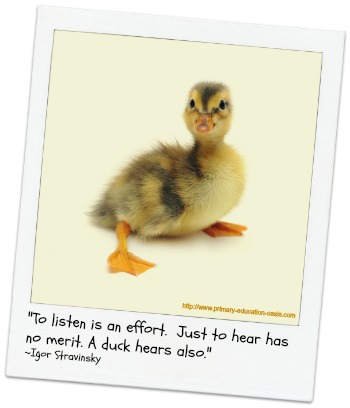Active listening skills are a critical part of the communication domain in a classroom performance assessment.
Being an effective listener means that students are using strategies to pay attention to auditory input.
Sometimes when students are not performing well in the classroom, there may be an issue with their receptive language.
How can we improve listening skills in our students? What about our ELL students who need to begin understanding English faster?
Assessing listening skills is often done by speech therapists. They are trained to screen and diagnose issues with how language is processed.
But nearly all of our students need help with this. We can do integrate it into our lessons while we teach kids to read.
A classroom teacher can note signs, issues and provide information regarding both academics and behavior that are impacting a student, but a teacher may not make an actual diagnosis. However, we can (and should) actively work on developing and improving our students’ active listening skills.
Types of Listening
There are actually six distinct areas in the Active Listening Domain that impact school achievement:
- Listening Skills
- Vocabulary
- Comprehension
- Analysis
- Classroom Directions
- Classroom Discourse
For the sake of shortening a lengthy topic, the areas will be put into three groups:
- Skills
- Vocabulary
- Instructions
Effective Listening Skills
Listening skills means that the student can attend to information in a way that allows him/her to process it. An effective listener can disregard other sounds that would interfere with comprehension. The listener is able to focus and sustain attention.
Assessing Listening Skills
The student should:
- Look at whomever is talking
- Does not need repetition
- Responds appropriately within 3-5 seconds
- Comprehends what is being said in a “competitive speech” environment (i.e. cafeteria, gym, etc.)
- Recognizes transitions between words, phrases and sentences
- Waits for the speaker to finish before responding
- Will ask for clarification if needed (i.e. Where? Did you mean…?)
- Writes well to dictation
- Comprehends inferences
- Can identify the purpose and draw a conclusion from an oral presentation
Listening Vocabulary
Vocabulary is key. When a student is having trouble understanding an interactive read aloud and I know he or she has been listening, I immediately look at listening vocabulary.
Listening vocabulary means that a person has enough known essential words to be able to comprehend auditory information. You will know if a child is struggling with listening vocabulary through simple observational assessments of their active listening skills.
Assessing Listening Vocabulary
The student should:
- Understand and use age-appropriate vocabulary
- Learn new vocabulary easily and be able to use it
- Recognizes homonyms and how they relate to the context of the oral presentation
- Understands synonyms and antonyms
- Understands and uses idioms, metaphors and similes
- Will recognize sarcasm
- Uses vocabulary to enhance listening comprehension
- Can monitor and adjust vocabulary to situations outside the classroom
Following Instructions
One of the most difficult things for many students is to comprehend (receptive language) more than two-step directions. Often a child cannot perform a required task due to multiple oral instructions being given.
In this case, it is critical that simple directions be written down in a list format or shorten instructions and give more only after completion of a required task.
We also expect our students to follow implied directions, such as how to act in certain situations. We expect students to infer our meaning, or “read between the lines.” Students who lack these skills often cannot succeed with implied directions.
Assessing Listening for Instructions
The student should:
- Understands and responds appropriately to direct requests
- Understands inferential requests for information
- Follows multi-step directions as appropriate for grade level
- Follows directions for both familiar and unfamiliar routines
- Can listen and adjust behaviors according to new information and directions
- Understands differences between student-teacher talk and peer-peer talk
- Applies rules for interaction in different social situations at school
Teaching students to actively listen and respond appropriately isn’t just an academic skill – it’s a life skill.
